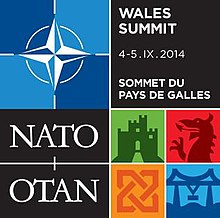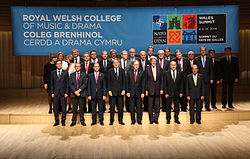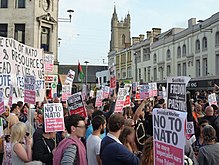2014 Wales summit
| NATO Summit Wales 2014 2014 Newport Summit | |
|---|---|
 Logo of the 2014 Wales Summit | |
| Host country | United Kingdom |
| Date | 4–5 September 2014 |
| Venue(s) | Celtic Manor, Newport |
| Cities | Newport, Cardiff |
| Website | NATO Summit Wales 2014 |

The 2014 Wales Summit of the North Atlantic Treaty Organization (NATO) was the 25th summit of the heads of state and heads of government of the NATO countries, held in Newport, Wales on 4 and 5 September 2014. Such summits are sporadically held and allow leaders and officials from NATO Allies to discuss current issues of mutual concern and to plan strategic activities. The 2014 summit has been described by US Navy Admiral James G. Stavridis as the most important since the fall of the Berlin Wall.[1]
Background
[edit]The summit was hosted by British Prime Minister David Cameron. Attendees included Canadian Prime Minister Stephen Harper, US President Barack Obama, German Chancellor Angela Merkel, French President François Hollande, Italian Prime Minister Matteo Renzi and Spanish Prime Minister Mariano Rajoy.

There were another 180 VIPs, and 4,000 delegates and officials from approximately 60 countries.[2]
The official logo for the summit included a panel with four quadrants, each bearing a stylised symbol of Newport or Wales: a Celtic knot, the Welsh Dragon, Newport Transporter Bridge and a Welsh castle.[3] The entrance to the venue was fronted by a full-scale replica of a Eurofighter Typhoon.[4][5]
Agenda
[edit]
World leaders met at the Celtic Manor, and informally at other locales in and around Cardiff. They discussed ongoing events in the world, such as terrorism, cyberwarfare, and other areas of national security interest to the member states.
Ukrainian President Petro Poroshenko had a joint discussion with EU big four leaders and US President Barack Obama before the official start of the Summit, to discuss the crisis with Russia.[6][7][8]
Outcomes
[edit]
The following declarations and agreements were made at the Summit:
- Wales Summit Declaration[9]
- Framework Nation Concept (FNC)[10][11][12][13][14][15][16]
- FNC/UK - see Joint Expeditionary Force
- FNC/DE - German-led FNC on 1) Deployable Headquarters; 2) Joint Fires; 3) Air and Missile Defence; 4) Joint Intelligence, Surveillance, and Reconnaissance[17]
- FNC/IT - Italian-led FNC on stabilization operations[17][18][19]
- NATO Readiness Action Plan[20]
- NATO Security Capacity Building Initiative[20]
- Armed Forces Declaration[21]
- Joint Statement of the NATO-Ukraine Commission[22]
- Declaration on Afghanistan[23]
- The Wales Declaration on the Transatlantic Bond[24]
Russia and Ukraine
[edit]Immediately prior to the summit on 3 September 2014 French President François Hollande announced the postponement of delivery of the first Mistral-class amphibious assault ship which had been sold to Russia, a ship provisionally named Vladivostok, due to the Russo-Ukrainian War.[25][26]
At the end of the summit Ukrainian President Poroshenko announced the Minsk Protocol, a ceasefire which had been agreed with the separatist leader Alexander Zakharchenko under terms proposed by Russian President Vladimir Putin. The protocol was cautiously welcomed by NATO leaders.[27]
On 12 September 2014 the EU announced a much wider expansion of its sanctions programme over the Russian involvement in the war in Ukraine.[28]
On 12 September a communiqué of the US Treasury announced a sweeping ban on the Russian defense sector.[29]
Wales Pledge
[edit]For the first time, the Allies formally pledged to aim to move towards what had previously been an informal guideline based on Article 3 of spending 2% of their gross domestic products on defense, and 20% of that on new equipment.[30] For countries which spend less than 2% they agreed upon that these countries "aim to move towards the 2% guideline within a decade".[9] This pledge was the brainchild of US Secretary of Defence Chuck Hagel. In 2015, five of its 28 members met that goal.[31][32][33] In the aftermath of the pledge, defense spending increased among NATO members.[34] At the beginning of 2018, eight of the 29 members either were meeting the target or were close to it; six others had laid out plans to reach the target by 2024 as promised; and Norway and Denmark had unveiled plans to substantially boost defense spending (including Norway's planned purchase 52 new F-35 fighter jets).[35]
Support for Military Intervention Against ISIL
[edit]On 5 September 2014, the U.S., Australia, Canada, Denmark, France, Germany, Italy, Turkey, and the United Kingdom, agreed to support anti-ISIL forces in Iraq and Syria with supplies and air support.[36]
Joint Expeditionary Force (FNC/UK)
[edit]On the initiative of the UK, the multinational Joint Expeditionary Force was officially launched with a Letter of Intent at and peripheral to the Summit.[37] It was subsumed under the new “Framework Nations Concept” rubric.[38][39] Germany, the UK and Italy were to act as framework nations for groups of Allies coming together to work multi-nationally for the joint development of forces and capabilities required by NATO.[40][10]
Criticism
[edit]A retired German politician, Walther Stützle, former defense Parliamentary Secretary of State (until 2002) in the SPD's First Schröder cabinet and former head of the Stockholm International Peace Research Institute (until 1991), criticized the summit agenda for its focus on military details and not political perspectives. Stützle said that the Russian Federation was not a military threat to NATO but criticized that new NATO members' policies were not détente and negotiation with the Russian Federation.[41]
Protestors and security detail
[edit]
In both Newport and Cardiff, road closures and security measures, starting weeks in advance of the summit, created widespread disruption.[42] Thirteen miles (21 km) of security fencing, 2.7 m (9 ft) high, was erected around the Newport hotel venue[42] and 10 miles (16 km) of fencing put up around Cardiff city centre. Businesses in the vicinity of security fencing in Cardiff reported a drop in trade by up to a third.[43] This fencing was based on and expanded, the 'National Barrier Asset' which is held in reserve for similar events.
Security included around 9,500 specially trained police officers patrolling the streets of the two cities, military helicopters including US Osprey V22s and the Royal Navy's new £1bn Type 45 destroyer HMS Duncan stationed in Cardiff Bay.[44]

Protests, demonstrations, and marches took place in Newport and Cardiff involving several hundred people, though the turnout was much lower than predicted.[45]
Leaders and other dignitaries in attendance
[edit]Member states
[edit]
|
|
Non-member states and organisations
[edit]
|
|
NATO Foreign ministers
[edit] Albania – Minister of Foreign Affairs Ditmir Bushati
Albania – Minister of Foreign Affairs Ditmir Bushati Belgium – Minister of Foreign Affairs Didier Reynders
Belgium – Minister of Foreign Affairs Didier Reynders Bulgaria – Minister of Foreign Affairs Daniel Mitov
Bulgaria – Minister of Foreign Affairs Daniel Mitov France – Minister of Foreign Affairs Laurent Fabius
France – Minister of Foreign Affairs Laurent Fabius Germany – Foreign Minister Frank-Walter Steinmeier
Germany – Foreign Minister Frank-Walter Steinmeier Italy – Foreign Minister Federica Mogherini[46]
Italy – Foreign Minister Federica Mogherini[46] Norway – Minister of Foreign Affairs Børge Brende
Norway – Minister of Foreign Affairs Børge Brende Spain – Minister of Foreign Affairs and Cooperation José Manuel García-Margallo
Spain – Minister of Foreign Affairs and Cooperation José Manuel García-Margallo United Kingdom – Foreign Secretary Philip Hammond
United Kingdom – Foreign Secretary Philip Hammond United States – Secretary of State John Kerry
United States – Secretary of State John Kerry
See also
[edit]References
[edit]- ^ Hjelmgaard, Kim (31 August 2014). "NATO summit 'most important' since fall of Berlin Wall". USA Today. Archived from the original on 1 September 2014. Retrieved 9 December 2015.
- ^ "Nato Wales 2014: Newport summit in numbers". BBC News. 29 August 2014. Retrieved 30 August 2014.
- ^ "Nato summit logo features Newport's Transporter Bridge – BBC News". BBC News. 25 June 2014. Retrieved 9 December 2015.
- ^ "Final preparations for Nato summit in Newport – BBC News". BBC News. 3 September 2014. Retrieved 7 February 2016.
- ^ "Summit Wales 2014 – Day 1". Getty Images. 4 September 2014. Retrieved 7 February 2016.
- ^ "Poroshenko to brief world leaders before NATO summit". Channel NewsAsia. 4 September 2014. Retrieved 8 September 2014.
- ^ "Obama, Cameron, Merkel, Hollande y Renzi se reunirán con presidente de Ucrania – Noticias | TeleticaMovil". teletica.com. Retrieved 12 September 2014.
- ^ "Ucraina. Renzi arriva al vertice Nato, summit G5 su Ucraina apre incontri". Internazionale (in Italian). Rome. 4 September 2014.
- ^ a b North Atlantic Alliance (5 September 2015). Wales Summit Declaration (PDF). Meeting of the North Atlantic Council, 4–5 September 2014. Government Digital Service. Archived from the original (PDF) on 21 June 2015. Retrieved 7 February 2016.
- ^ a b Zandee, Dick (December 2019). "Another solution with added value? The European Intervention Initiative as a new kid on the block of multinational defence cooperation" (PDF).
- ^ Glatz, Rainer L.; Zapfe, Martin (September 2017). "Ambitious Framework Nation: Germany in NATO - Bundeswehr Capability Planning and the "Framework Nations Concept"" (PDF).
- ^ Saxi, Håkon Lunde (2017). "British and German initiatives for defence cooperation: The Joint Expeditionary Force and the Framework Nations Concept". Defence Studies. 17 (2): 171–197. doi:10.1080/14702436.2017.1307690. S2CID 157450274.
- ^ Allers, Robin (26 April 2024). "The framework nation: can Germany lead on security?". International Affairs. 92 (5): 1167–1187. doi:10.1111/1468-2346.12702. JSTOR 45238094.
- ^ Monaghan, Sean; Arnold, Ed (27 June 2022). "Indispensable: NATO's Framework Nations Concept beyond Madrid".
- ^ Zandee, Dick (July 2022). "Specialising in European defence To choose or not to choose?" (PDF).
- ^ Major, Claudia; Mölling, Christian (December 2014). "The Framework Nations Concept Germany's Contribution to a Capable European Defence" (PDF).
- ^ a b Pettinari, Francesco. "Possibilities and Challenges to the Creation of a Cooperative European Defence System" (PDF).
- ^ https://www.foi.se/rest-api/report/FOI-R--4672--SE.
{{cite news}}: Missing or empty|title=(help) - ^ https://css.ethz.ch/content/dam/ethz/special-interest/gess/cis/center-for-securities-studies/pdfs/CSSAnalyse218-EN.pdf.
{{cite news}}: Missing or empty|title=(help) - ^ a b "Defence and Related Security Capacity Building Initiative". NATO.
- ^ "NATO Summit 2014: Armed Forces Declaration – Publications". Government of the United Kingdom. Retrieved 12 September 2014.
- ^ "NATO Summit 2014: Joint Statement of the NATO-Ukraine Commission – Publications". Government of the United Kingdom. Retrieved 12 September 2014.
- ^ "Wales Summit Declaration on Afghanistan – Publications". Government of the United Kingdom. Retrieved 12 September 2014.
- ^ "The Wales Declaration on the Transatlantic Bond". NATO.
- ^ de la Baume, Maïa; Gladstone, Rick (3 September 2014). "France Postpones Delivery of Warship to Russia". The New York Times Company.
- ^ "Ukraine crisis: France halts warship delivery to Russia". BBC. 3 September 2014.
- ^ MacAskill, Ewen; Walker, Shaun (4 September 2014). "Nato leaders cautiously welcome Ukraine ceasefire agreement". The Guardian. Archived from the original on 4 September 2014. Retrieved 8 September 2014.
- ^ "UPDATE 1-EU raises pressure on Moscow with tougher sanctions". Reuters. 12 September 2014.
- ^ "Announcement of Expanded Treasury Sanctions within the Russian Financial Services, Energy and Defense or Related Materiel Sectors". U.S. DEPARTMENT OF THE TREASURY. 12 September 2014.
- ^ Techau, Jan (2 September 2015). "The Politics of 2 Percent: NATO and the Security Vacuum in Europe". Carnegie Europe. Retrieved 11 July 2018.
A month before [the alliance's summit in Riga in 2006], Victoria Nuland, then the U.S. ambassador to NATO, called the 2 percent metric the "unofficial floor" on defense spending in NATO. But never had all governments of NATO's 28 nations officially embraced it at the highest possible political level—a summit declaration.
- ^ "Military Spending by NATO Members". The Economist. 16 February 2017. Retrieved 4 March 2017.
- ^ Bendavid, Naftali (22 June 2015). "Just Five of 28 NATO Members Meet Defense Spending Goal, Report Says". The Wall Street Journal. Retrieved 4 March 2017.
- ^ Ivana, Kottasova (8 July 2016). "These NATO Countries are Not Spending Their Fair Share on Defense". CNNMoney. Retrieved 4 March 2017.
- ^ Becker, Jordan (2024). "Pledge and Forget? Testing the Effects of NATO's Wales Pledge on Defense Investment". International Studies Perspectives. doi:10.1093/isp/ekad027. ISSN 1528-3577.
- ^ Gramer, Robbie (27 June 2018). "Ahead of NATO Summit, U.S. President Exhorts Allies to Pay Up". Foreign Policy magazine. Retrieved 12 July 2018.
- ^ ‘U.S. Forms Anti-ISIS Coalition at NATO Summit’. Time, 5 September 2014. Retrieved 14 June 2015.
- ^ "International partners sign Joint Expeditionary Force agreement". GOV.UK. 5 September 2014.
- ^ "NATO's Framework Nations: Capabilities for an Unpredictable World". 17 April 2014.
- ^ https://www.atlanticcouncil.org/wp-content/uploads/2014/04/NATOs_Framework_Nations.pdf.
{{cite news}}: Missing or empty|title=(help) - ^ "News Article".
- ^ Stützle, Walther (4 September 2014). "Die NATO wird nicht bedroht" [NATO is not threatened]. deutschlandfunk.de (Interview) (in German). Interviewed by Friedbert Meurer. Köln, DE: Deutschlandfunk. Archived from the original on 5 September 2014.
- ^ a b Deans, David (7 August 2014). "Nato Summit 2014: Road closures and disruption in Cardiff city centre". Wales Online. Retrieved 1 September 2014.
- ^ Atwell, Jessica (28 August 2014). "Nato Summit 2014: Businesses near Cardiff Ring of Steel claim trade has dropped by a third since fence was erected". Wales Online. Retrieved 1 September 2014.
- ^ Paul Rowland (2 September 2014). "Nato Summit 2014: The main security measures in Newport and Cardiff". Wales Online. Retrieved 8 September 2014.
- ^ "Four arrests at anti-Nato protest in Cardiff". BBC News. 5 September 2014. Retrieved 6 September 2014.
- ^ "Vertice NATO: Matteo Renzi e Ministro Mogherini Arrivati in Galles". agenparl.com. Archived from the original on 7 September 2014. Retrieved 12 September 2014.
External links
[edit]- NATO Summit Wales 2014
- 2014 NATO Summit Media information
- Łukasz Kulesa (www.europeanleadershipnetwork.org): NATO at a Crossroads – Again: Recommendations for the Newport Summit, PDF (14 p.)
- Diplomatic conferences in the United Kingdom
- 2014 conferences
- 2014 in international relations
- 2014 in Wales
- 21st-century diplomatic conferences
- NATO summits
- Events in Newport, Wales
- 2014 pro-Russian unrest in Ukraine
- United Kingdom and NATO
- 2014 in British politics
- History of Newport, Wales
- September 2014 events in the United Kingdom
- Events in Cardiff
